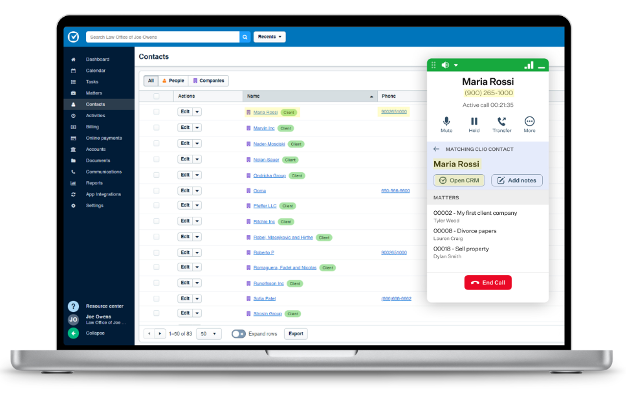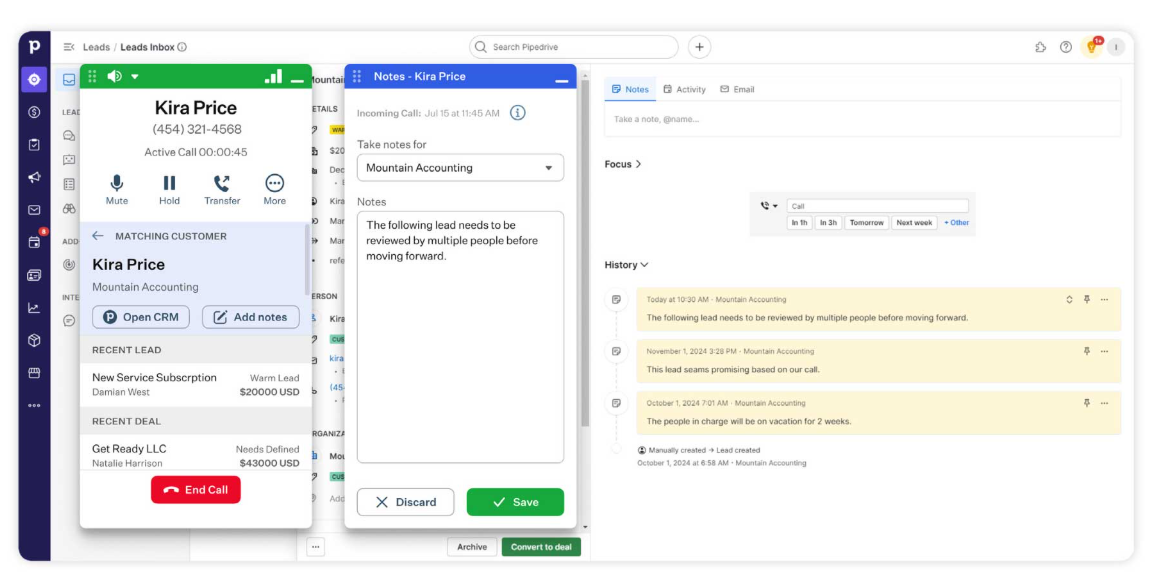9 great reasons to integrate your CRM tool with your business phone
Key Points
- CRM integrations are basically an information pipeline that lets data flow back and forth across the two platforms.
- A mini screen pops up on your computer when a caller's phone number matches one of your customers or prospects.
- You can take or make calls while working in your CRM platform without having to switch to your phone's desktop app.

For many, a typical work day is spent jockeying back and forth between business applications on computers, answering phone calls from customers and colleagues, attending conference calls, and responding to emails and sending texts. Sure, those tasks are necessary, but what if there was a more efficient solution? That’s where CRM VoIP integrations can help.
What exactly is a CRM VoIP integration?
CRM is short for the myriad of customer relationship management programs, like Salesforce, Zoho, Clio and Jobber, that contain valuable information about current and potential customers. VoIP stands for Voice over Internet Protocol and is the secret sauce that makes it possible for internet phone service providers to offer phone systems for businesses with dozens of voice, meeting and messaging features. A CRM VoIP integration is an application programming interface, commonly called an API, that allows you to share information between a CRM system and your VoIP business phone system. Think of it as an information pipeline that lets data flow back and forth across the two platforms.
Before we dive into why you should integrate your CRM and business phone, keep in mind these examples will vary depending on your CRM phone integration. While many CRM tools and phone service providers offer similar capabilities, there can be differences. Ready to learn how to be more efficient and improve customer relationships?
-
Click to take or make a call
Imagine you’re on your laptop putting together a customer email campaign in Salesforce when you get a phone call. A CRM VoIP integration lets you click to answer that call. No need to exit Salesforce or enter your phone application credentials.
It’s just as easy to make a call. Click on the phone number link from Salesforce and voila—the number for the customer or prospect starts connecting. This is so much easier than jotting down or memorizing the phone number while you switch over to a phone to dial it yourself.
Even better is the CRM phone integration gives you complete control of the call. You can mute yourself, put the call on hold, add a call participant or transfer the caller to another extension.
-
Get info from Caller ID Pop
If a phone number matches one of your customers or prospects, a screen appears with details about the caller. These informational screens go by many names: Caller ID pop, screen pop and real-time assist (RTA) cards and are more valuable than basic caller ID because they pull data directly from your CRM system.
For example, when an attorney using Clio gets a call from a client, a mini screen pops up with data, such as the caller’s name, phone number, brief descriptions of their past legal issues, and more.

-
Improve customer relationships
The Caller ID pop eliminates the need for the caller to explain who they are. Greet them by name and let them think you recognize their voice and remember all their past interactions with your company. Who doesn’t like feeling seen?
For more information, read Getting personal: How Salesforce Integration brings you closer to your customer.
-
Create automated records of calls
Another advantage of a CRM integration is that you can keep track of phone conversations, which is especially helpful in agencies that log billable hours. For example, when a matching client exists in AgencyZoom, a record of the call will automatically be created as a completed action for that matched contact. The call record includes whether the call was incoming or outgoing, who it was from and to, and the time and length of the call.
-
Record calls
When you’re working in your CRM and get a phone call from an important client, you can record the call for future reference if your phone system is linked to your CRM. It’s nice to be able to refer to a recorded call to verify the details for orders, follow up with answers to special requests, and capture notes to share with your team members.
-
Integrate contacts from your CRM system into your phone directory
If you enable contact integration through your CRM system, all of your CRM contacts will appear in your phone system’s personal directory that is located in the desktop app and in a new directory on your IP phone. Avoid the pain of manually entering contacts.
-
Take notes during a call
Instead of scribbling details on a Post-it and hoping you can decipher it later, type notes directly in the client’s record file. For example, in Pipedrive there is a Notes option in the Dialer module. This makes it easy to enter a quick note as you’re speaking to your caller. If you think of something you forgot to add after the call ends, no worries—just select the Add notes option and enter it while it’s still on your mind.

-
Automate tasks
As your business grows, you’ll appreciate finding shortcuts to streamline your processes. Brainstorm ways that your CRM and phone integration can help keep your team on track. For example, your CRM probably already has follow-up reminders and the ability to send periodic emails and text messages to clients and prospects. Train your staff to always ask callers about their communication preferences. Enter this info into your CRM so prospects can get automated messages in the manner they prefer.
-
Analyze call history to gain customer insight
When you collect and store data about customers calls directly in your CRM, you have a treasure trove of data just waiting to be analyzed. Make a habit of periodically reviewing your call logs to see if there is anything you can do to improve the customer experience. For instance, if you find that you get a lot of calls prior to the holidays about sales and extended hours, consider sending out timely text messages or emails with that information. Use call logs for better service.
Ready to integrate your CRM with VoIP?
Customer relationship management integration with VoIP is a perfect pairing. While VoIP and CRM systems both are powerful tools on their own, together they allow teams to be even more productive. Besides CRM integrations, Ooma Office also has integrations for Microsoft Dynamics 365 and Square—a point-of-purchase product. Check out the growing number of VoIP integrations available from Ooma.





